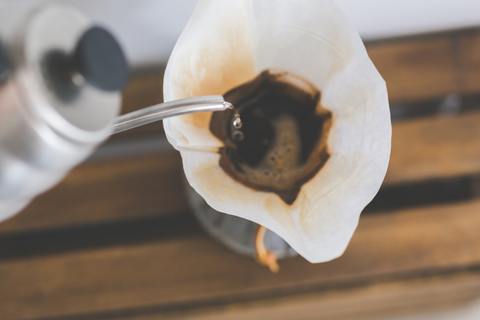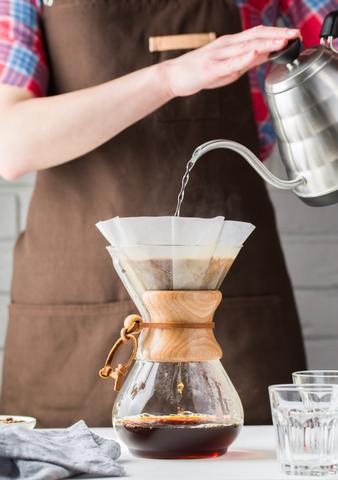To Stir or Not to Stir: That is the Question

With all the enthusiasm about pour-over, it is no wonder that people can oftentimes get into heated debates over the “proper” technique. And while there may or may not be an ideal procedure when it comes to making one, there is one step some people swear by, that others swear against: stirring the coffee grounds. Let’s consider stirring and whether or not it is something you should be doing in your pour-over.
You should initially note that there is generally no stirring involved in the standard pour over technique of blooming the coffee, then doing 2-3 pours while keeping the tip of the gooseneck kettle as close to the bed of coffee grounds as possible. However, a lot of people insist on stirring the grounds with a spoon or chopstick at different stages during this brewing process.
Stirring After the Bloom?

One popular point that a lot of people stir at is just after blooming. Some say that this ensures that all the coffee grounds are wet and eliminates dry pockets. However, if you are blooming the grounds correctly, there is no need to stir after blooming. Stirring the bloomed coffee grounds somewhat defeats the purpose of blooming to begin with- the slight agitation that a gentle pour provides. This agitation- in addition to the additional carbon released as the pour continues – is usually more than enough to break through the crust.
One reason people give for stirring the bloom is that it results in more gases being released, agitating the grounds less during brewing. This initially sounds desirable, but this reduction in agitation is outweighed by the over-agitation of the stirring itself.
Stirring after X Pours?

Some people like to stir after some number of pours- for example, after the second pour is finished settling. However, stirring after a pour requires a great deal of caution. With a pour over, some degree of agitation is expected- from the pour, gases releasing, or other variables, and the amount of agitation that ends up occurring is already usually an ideal amount assuming proper pouring technique. Introducing a stirring step can lead to over agitation within the grounds, in turn leading to over-extraction. Stirring during pour-over is sort of like squeezing a tea bag; just as squeezing a tea bag after brewing releases unnecessary tannins into the tea, adding bitterness, stirring the coffee grounds significantly in hot water provides a similar result by potentially over-extracting the coffee.
Stirring proponents claim that it introduces less extracted grounds to the top of the pour over cone, resulting in a more even extraction. However, this isn’t really the case. Water works the same way that electricity does, travelling through the path of least resistance. Stirring the bed of coffee grounds temporarily allows a less restricted channel to open up and water within the cone may move through without extraction, leading to under-extracted, watered-down coffee.
What if you are Making A Lot of Coffee?

One potential scenario where stirring could conceivably be beneficial, however, is if you’re making a lot of coffee at one time. For anything less than about 20 ounces, stirring is not necessary. However, if you are making significantly more than that, it is possible that the natural agitation from pouring water- and the resulting gas release- might not be quite sufficient. This does depend on the style of pour over you are using, however. If you have a pour-over with an elongated width – not ending in a point – there will most likely be enough space at the bottom of the pour over for the ground coffee to extract correctly without stirring. However, if you have something along the lines of a Hario V60, or a Chemex – both using filters that end at a point – then a small amount of stirring might be needed for large quantities of ground coffee to ensure that the whole brew chamber is getting saturated. A quality pouring technique could probably still produce a proper brew- but if you do notice that the resulting coffee tastes a little too strong or weak in such a situation, a careful stir could potentially be useful. Adjusting the grind is still usually the better bet.
Conclusion
Stirring at any step in the pour over making process is generally frowned upon and not preferable. Stirring generally creates an inconsistent brew- it can agitate the grounds too much, causing over, or even under, extraction. As we discussed previously, there are more effective ways to ensure an even extraction. The SCAA mentions no stirring step in their standardized pour over technique, with the exception of the unavoidable agitation that comes from pouring the water. If you are unhappy with the coffee your pour-over is producing and considering trying to stir the grounds, we’d recommend you evaluate other options such as varying your pouring technique or your grind size. Experimenting with these variables can get you to a great, repeatable cup of pour-over coffee- a stark contrast to the inconsistency introduced by stirring.
